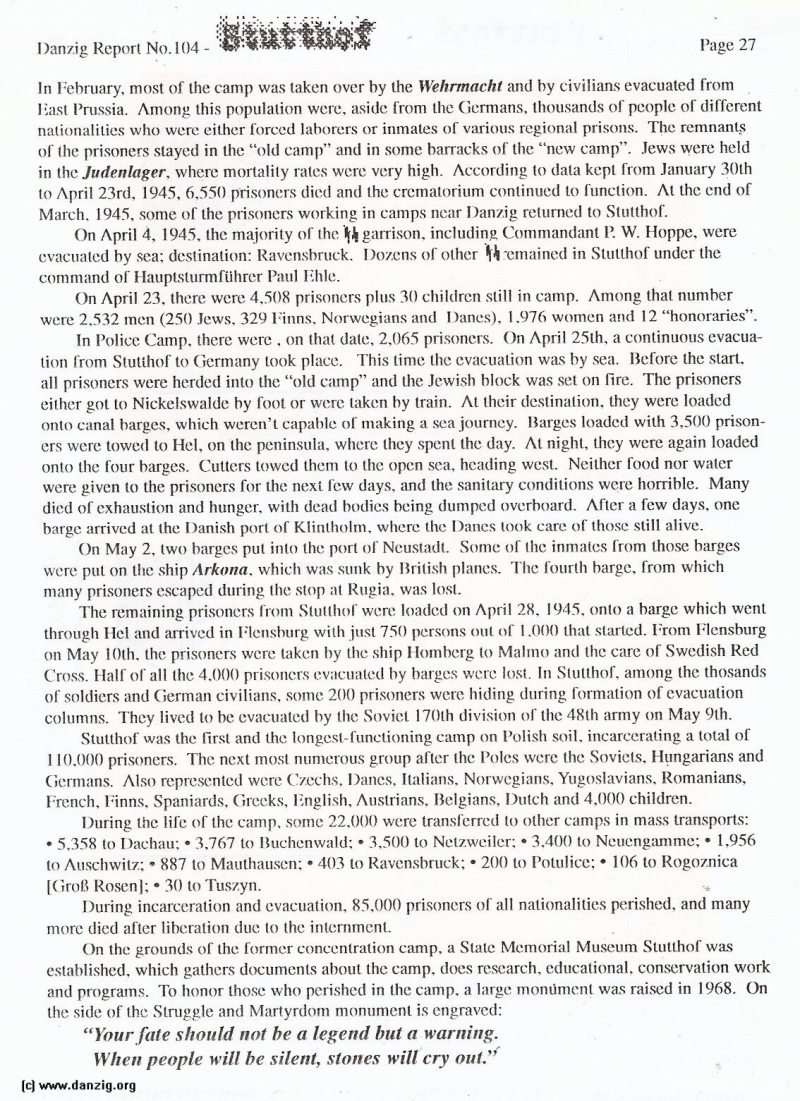
In February. most of the camp was taken over by the Wehrmackt and by civilians evacuated from East Prussia. Among this population were, aside from the Germans. thousands of people of different nationalities who were either forced laborers or inmates of various regional prisons. The remnantc of the prisoners stayed in the “old camp” and in some barracks of the “new camp”. Jews were held in the .Iudeiilager. where mortality rates were very high. According to data kepi from January 30th to April 23rd. 1945, 6,55() prisoners died and the crematorium continued to [unction. At the end of March. 1945. some of the priSonerS working in camps near I )aniig returned to Stuithof.
On April 4. 1945. the majority of the garrison. including Commandant P W. Hoppe. were evacuated by sca: destination: Ravenshruck. I )ozens of other emaincd in Stutthof under the command of I lauptsturmftlhrer Patti Ehic.
On April 23. there were 4.508 prisoners plus 30 children still in camp. Among that number were 2.532 men (250 Jews, 329 Finns. Norwegians and I)anes). 1.976 women and 12 “honoraries”.
In Police Camp. there were . on (hat dale. 2,065 prisoners. On April 25th. a continuous evacuat ion From Stutthof to (‘erin any took place. This time the evacuation was by Sea. Before the start. all prisoners were herded into the “old camp” and the Jewish block was set on flre. The prisoners either got to Niekelswalde by foot or were taken by train. At their destination, they were loaded onto canal barges. which weren’t capable of making a sea journey. Barges loaded with 3,500 prisone rs were towed to Hel, on the peninsula, where they spent the day. At night, they were again loaded onto the Four barges. Cutters towed them to the opcn Sea, heading west. Neither food nor water were given to the prisoners for the next few days. and the sanitary conditions were horrible. Many died of exhaustion and hunger. with dead bodies being dumped overboard. Alter a few clays, one barge arrived at the I )anish port of Klinlholm. where the I )ancs took care of those still alive.
On May 2. two barges put into the port of Neusiadt. Some of the inmates from those barges were put on the ship /trkma. which was sunk by British planes. 1’he fourth barge, from which many prisoners escaped during the stop at Rugia. was lost.
The remaining prisoners from Sutiliof were loaded on April 28. 1945. onto a barge which went through I id and arrived in Flenshurg with just 751) persons (flit of I .00() that started. From Flenshurg on May 10th. the prisoners were taken by the ship Ilomberg to Malmo and the care of Swedish Red Cross. Half of all the 4.00() prisoners evacuated by barges were lost. In Siutthof. among the thosands of soldiers and German civilians, some 201) prisoners were hiding during formation of evacuation columns. They lived to he evacuated by the Soviet 170th division of the 48th army on May 9th.
Stutthof was the flrst and the longest- Functioning camp on Polish soil, incarcerating a total of 110.000 prisoners. The next most numerous group after the POleS were the Soviets. Hungarians and 33errnaris. Also represented were Czechs. l)anes. Italians. Norwegians. Yugoslavians. Romanians. French. Finns. Spaniards. (ireeks, I nglish. Austrians. Belgians. I )ulch and 4.000 children. I )uring the life of the camp. some 22,000 were transferred to other camps in mass transports: • 5.358 to I achau; • 3.767 to Ikichenwald: • 3.500 to Netzweiler: • 3.400 to Neuengamrne: • 1.956 to Auschwitz; • 887 to Mauthausen: • 403 to Ravensbruck: • 200 to Potuhee: • 106 to Rogoznica [(;rI Rosenj: . 30 to Tuszyn.
During incarceration and evacuation, 85.000 prisoners of all nationalities perished, and many more died after liberation due to the internment.
On the grounds of the former concentration camp. a State Memorial Museum Stutihof’ was established, which gathers documents about the camp. does research, educational. conservation work and programs. To honor those who perished in the camp, a large mondment was raised in 1968. On the side of the Stniggle and Martyrdom monument is engraved: “Your fate should not be a legciid but a warning. Wlieii people will he silent, stones will cry out.”
Danzig Report Vol. 1 - Nr. 104 - July - August - September - 1999, Page 28.
Hits: 3278
Added: 25/07/2015
Copyright: 2025 Danzig.org

